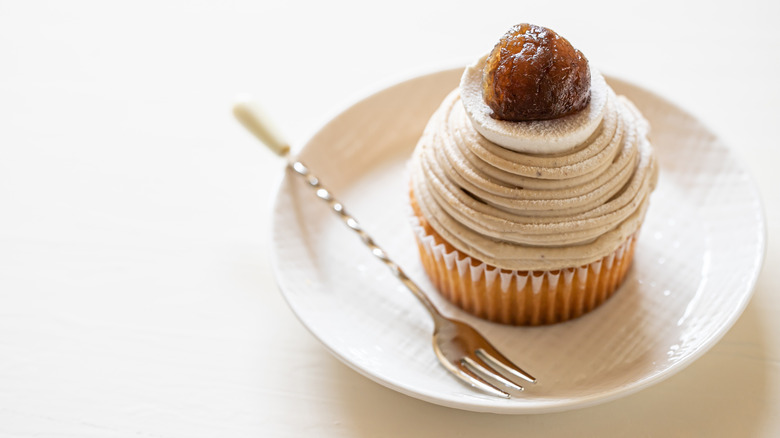Mont Blanc Dessert Makes Chestnut The Main Character
Forget about standard dessert flavors like chocolate or strawberry, and consider sampling a sweet treat centered around chestnuts, instead. While chestnuts may not be used so widely in the North American culinary world, they're hot stuff in European countries like France and Hungary, where they often appear in desserts and baked goods around the holiday season (although not exclusively).
And one particularly delectable vehicle for chestnuts is a French dessert Mont Blanc. Named for its resemblance to a snow-capped mountain, the Mont Blanc features a meringue base, topped with a sweet chestnut cream, and then a little whipped cream as the "snow" on top. The exact form of the dessert can vary –– some upscale patisseries may also coat the outside of the dessert with piped chestnut cream as if the dessert was coated in a layer of chestnut noodles. It was first created in Paris in the 19th century but has been tinkered with along the way. You'll find variations like the Japanese sponge-based version created in the mid-1900s or recipes featuring additional flavors and elements as in this Chestnut and Meringue Mont Blanc recipe. But despite numerous iterations, one thing remains constant: Mont Blanc is a showcase for the buttery flavor of chestnuts.
Can I make it at home?
Mont Blancs are not particularly well-known in most countries except for France, so while you could try hunting one down in the United States, it might be tricky unless you're lucky enough to have a specialty French pastry maker within reach. But if you want to impress your guests with this flashy dessert, it's pretty plausible to make a batch of Mont Blancs at home, and if you opt for a straightforward recipe, they're really not finicky.
Most Mont Blanc ingredients and methods are super standard: You'll need egg whites, sugar, and vanilla for the meringue base: They're whipped together until they're stiff and then baked. The cream topping is even easier since all you have to do is whip together cream, sugar, vanilla, and maybe some powdered sugar and chocolate to garnish the final product. It's only the chestnut filling that's a little tricky. If you're working with whole chestnuts, there's a more finicky process of roasting and boiling them before blending them with vanilla and sugar, but if you work with chestnut purée, most of that work is skipped. Then it's just a matter of assembling the parts into a dessert that looks like a lot more work than it actually is.
Where to source chestnuts
One of the challenges of making a Mont Blanc is finding the chestnuts. You might be able to find them in super well-stocked grocery stores, or else specialty Italian markets, or maybe farmer's markets. But if not, there are retailers online that'll ship them to you, and they can be found on some major sites like Amazon, if you're lucky. Buying chestnut purée might be easier. Since it's canned or jarred and therefore keeps well, it's the kind of thing you can find in gourmet stores like Zabar's in New York and even major sites like Amazon.
Alternatively, if making your own Mont Blanc sounds like too much work, you could always just book a trip to France to find it. Parisian patisserie Angelina is known as the famed place to pick one up. Or, somewhat unexpectedly, you could also head to Japan; Mont Blancs are also unexpectedly popular there, but that's a whole other story.


